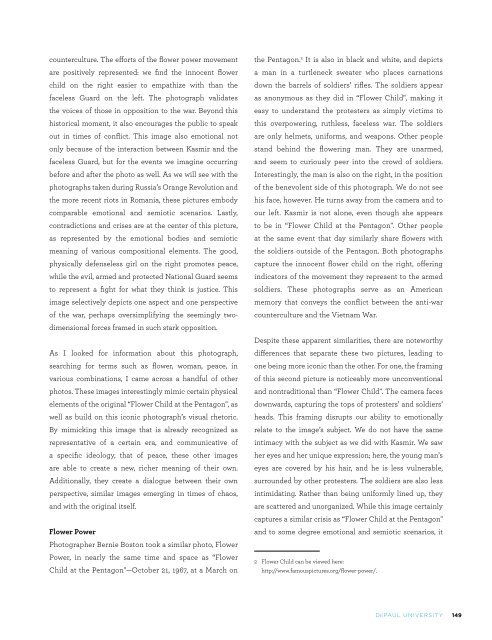UNDERGRADUATE
Ycb5305N2JX
Ycb5305N2JX
Create successful ePaper yourself
Turn your PDF publications into a flip-book with our unique Google optimized e-Paper software.
seems to depend on the rhetoric that “Flower Child" has<br />
established to civically perform on its own.<br />
Nearly forty years later two photographs were taken that<br />
each depict a woman placing flowers in police officers’<br />
shields outside of Kiev, Ukraine’s presidential office. 3 We<br />
notice an obvious difference in these images from “Flower<br />
Child at the Pentagon": they are in color. In the first photo,<br />
a blond-haired woman seems to be smiling as her she puts<br />
a bright, coral colored carnation in the openings of a shield.<br />
The other vibrant colors in the photograph come from<br />
the woman’s pink scarf, a large yellow ribbon tied around<br />
her wrist, and three stickers that are on the low wall that<br />
separates the soldiers from the rioters. The lively colors all<br />
come from the side of the wall that protests, that is against<br />
what is going on behind the shields. The men and women<br />
behind the wall are just barely visible above their shields.<br />
All we see of them are black helmets, which have a clear<br />
cover that extends over their eyes. Similar to “Flower Child<br />
at the Pentagon", the military personnel clump together<br />
by means of their anonymous foreboding attire. However,<br />
the soldiers are no longer on the offense pointing rifles<br />
and bayonets at the onlookers. They are now only visible<br />
on the defense. It was important in “Flower Child at the<br />
Pentagon" and Flower Power for the protesters to use<br />
peaceful means to communicate their message promoting<br />
peace and to abort the Vietnam War. In Ukraine, the values<br />
are different. Many Ukrainians suspected the election was<br />
unfair because of voter intimidation and electoral fraud.<br />
Leonid Kuchma supposedly won the election, despite<br />
overwhelmingly popular support of Viktor Yushchenko. In<br />
protest, citizens wore the color of Yuschenko’s campaign,<br />
orange, and flooded Ukraine’s capital Kiev. The protesters<br />
are not present because they want peace, but because they<br />
want justice. Perhaps this is the most important historical<br />
different between these photographs of the Orange<br />
3 The first picture can be viewed here:<br />
http://mostepicstuff.com/wp-content/uploads/2014/12/16-Ukranian-<br />
Women-Placing-Flowers-In-Police-Shields.jpg.<br />
The second can be viewed here: https://s-media-cache-ak0.pinimg.<br />
com/736x/cf/f5/2e/cff52ebd7c52ebddbd8738a3bd8933d6.jpg.<br />
Revolution and those taken at the March on the Pentagon.<br />
In “Flower Child at the Pentagon", there was a war that<br />
protesters wanted to stop. In this photo, there would not<br />
have been a crisis had citizens not acted in response to the<br />
election. Interestingly, the more recent photos demonstrate<br />
citizens taking a more active role in civic engagement.<br />
We might even go so far as to wonder if “Flower Child<br />
at the Pentagon" validated young people’s feelings and<br />
encouraged them be more involved in their communities.<br />
In the second photograph taken nearly the same time<br />
and space, a woman dressed in a black coat strains to<br />
reach over the low wall and place the carnations, perhaps<br />
slightly pinker than the previous, in the soldiers’ shields.<br />
She holds two flowers in her left hand, while the right hand<br />
shares another. Similar to “Flower Child at the Pentagon",<br />
the shields stretch into the background, seeming to go<br />
on forever. The men still wear their black helmets and<br />
clear shields, but their faces are barely recognizable.<br />
Now we see a mass of ominous black helmets behind<br />
the front row of shielded soldiers, where before we only<br />
saw the front line. Again, all of the vibrant colors are<br />
on the right, behind or on the woman: the flowers, an<br />
orange stripe on her hat, other yellow flowers in the<br />
background, some orange-yellow ponchos that other<br />
onlookers wear. Both of these women are on the right of<br />
the photograph, flowers in hand, facing a line of armed<br />
uniformed military, as in “Flower Child". The question<br />
remains: why are these people sharing flowers with the<br />
force who is blocking them from intervening? Why does<br />
this type of image keep reappearing? There is a perceived<br />
helplessness embodied and felt by citizens on the right<br />
of each of these images. However, these pictures validate<br />
their actions and this kind of peaceful response. Kasmir<br />
reflected the values of the flower power counterculture<br />
she was a part of, promoting peace in spite of a war. These<br />
women face shields, not bayonets. Are they the threat?<br />
The relationship between the left and right halves of the<br />
photographs is perhaps not as deceivingly simple here.<br />
We cannot identify the offense and defense, the right and<br />
wrong, the innocents and threats. Yet, it is still women<br />
150 CREATING KNOWLEDGE


